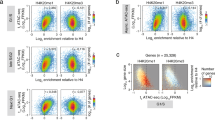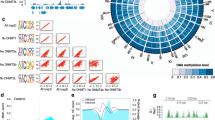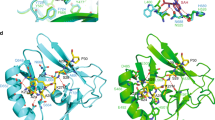Abstract
Eukaryotic chromatin is separated into functional domains differentiated by post-translational histone modifications, histone variants and DNA methylation1,2,3,4,5,6. Methylation is associated with repression of transcriptional initiation in plants and animals, and is frequently found in transposable elements. Proper methylation patterns are crucial for eukaryotic development4,5, and aberrant methylation-induced silencing of tumour suppressor genes is a common feature of human cancer7. In contrast to methylation, the histone variant H2A.Z is preferentially deposited by the Swr1 ATPase complex near 5′ ends of genes where it promotes transcriptional competence8,9,10,11,12,13,14,15,16,17,18,19,20. How DNA methylation and H2A.Z influence transcription remains largely unknown. Here we show that in the plant Arabidopsis thaliana regions of DNA methylation are quantitatively deficient in H2A.Z. Exclusion of H2A.Z is seen at sites of DNA methylation in the bodies of actively transcribed genes and in methylated transposons. Mutation of the MET1 DNA methyltransferase, which causes both losses and gains of DNA methylation4,5, engenders opposite changes (gains and losses) in H2A.Z deposition, whereas mutation of the PIE1 subunit of the Swr1 complex that deposits H2A.Z17 leads to genome-wide hypermethylation. Our findings indicate that DNA methylation can influence chromatin structure and effect gene silencing by excluding H2A.Z, and that H2A.Z protects genes from DNA methylation.
This is a preview of subscription content, access via your institution
Access options
Subscribe to this journal
Receive 51 print issues and online access
$199.00 per year
only $3.90 per issue
Buy this article
- Purchase on Springer Link
- Instant access to full article PDF
Prices may be subject to local taxes which are calculated during checkout




Similar content being viewed by others
References
Malik, H. S. & Henikoff, S. Phylogenomics of the nucleosome. Nature Struct. Biol. 10, 882–891 (2003)
Bernstein, E. & Hake, S. B. The nucleosome: a little variation goes a long way. Biochem. Cell Biol. 84, 505–517 (2006)
Bhaumik, S. R., Smith, E. & Shilatifard, A. Covalent modifications of histones during development and disease pathogenesis. Nature Struct. Mol. Biol. 14, 1008–1016 (2007)
Goll, M. G. & Bestor, T. H. Eukaryotic cytosine methyltransferases. Annu. Rev. Biochem. 74, 481–514 (2005)
Gehring, M. & Henikoff, S. DNA methylation dynamics in plant genomes. Biochim. Biophys. Acta 1769, 276–286 (2007)
Klose, R. J. & Bird, A. P. Genomic DNA methylation: the mark and its mediators. Trends Biochem. Sci. 31, 89–97 (2006)
Feinberg, A. P., Ohlsson, R. & Henikoff, S. The epigenetic progenitor origin of human cancer. Nature Rev. Genet. 7, 21–33 (2006)
Mizuguchi, G. et al. ATP-driven exchange of histone H2AZ variant catalyzed by SWR1 chromatin remodeling complex. Science 303, 343–348 (2004)
Guillemette, B. & Gaudreau, L. Reuniting the contrasting functions of H2A.Z. Biochem. Cell Biol. 84, 528–535 (2006)
Guillemette, B. et al. Variant histone H2A.Z is globally localized to the promoters of inactive yeast genes and regulates nucleosome positioning. PLoS Biol. 3, e384 (2005)
Li, B. et al. Preferential occupancy of histone variant H2AZ at inactive promoters influences local histone modifications and chromatin remodeling. Proc. Natl Acad. Sci. USA 102, 18385–18390 (2005)
Millar, C. B., Xu, F., Zhang, K. & Grunstein, M. Acetylation of H2AZ Lys 14 is associated with genome-wide gene activity in yeast. Genes Dev. 20, 711–722 (2006)
Raisner, R. M. et al. Histone variant H2A.Z marks the 5′ ends of both active and inactive genes in euchromatin. Cell 123, 233–248 (2005)
Zhang, H., Roberts, D. N. & Cairns, B. R. Genome-wide dynamics of Htz1, a histone H2A variant that poises repressed/basal promoters for activation through histone loss. Cell 123, 219–231 (2005)
Barski, A. et al. High-resolution profiling of histone methylations in the human genome. Cell 129, 823–837 (2007)
Brickner, D. G. et al. H2A.Z-mediated localization of genes at the nuclear periphery confers epigenetic memory of previous transcriptional state. PLoS Biol. 5, e81 (2007)
Deal, R. B., Topp, C. N., McKinney, E. C. & Meagher, R. B. Repression of flowering in Arabidopsis requires activation of FLOWERING LOCUS C expression by the histone variant H2A.Z. Plant Cell 19, 74–83 (2007)
Meneghini, M. D., Wu, M. & Madhani, H. D. Conserved histone variant H2A.Z protects euchromatin from the ectopic spread of silent heterochromatin. Cell 112, 725–736 (2003)
Updike, D. L. & Mango, S. E. Temporal regulation of foregut development by HTZ-1/H2A.Z and PHA-4/FoxA. PLoS Genet. 2, e161 (2006)
Venkatasubrahmanyam, S., Hwang, W. W., Meneghini, M. D., Tong, A. H. & Madhani, H. D. Genome-wide, as opposed to local, antisilencing is mediated redundantly by the euchromatic factors Set1 and H2A.Z. Proc. Natl Acad. Sci. USA 104, 16609–16614 (2007)
Mito, Y., Henikoff, J. G. & Henikoff, S. Genome-scale profiling of histone H3.3 replacement patterns. Nature Genet. 37, 1090–1097 (2005)
Zilberman, D., Gehring, M., Tran, R. K., Ballinger, T. & Henikoff, S. Genome-wide analysis of Arabidopsis thaliana DNA methylation uncovers an interdependence between methylation and transcription. Nature Genet. 39, 61–69 (2007)
Zhang, X. et al. Genome-wide high-resolution mapping and functional analysis of DNA methylation in Arabidopsis . Cell 126, 1189–1201 (2006)
Vaughn, M. W. et al. Epigenetic natural variation in Arabidopsis thaliana . PLoS Biol. 5, e174 (2007)
Cokus, S. J. et al. Shotgun bisulphite sequencing of the Arabidopsis genome reveals DNA methylation patterning. Nature 452, 215–219 (2008)
Lister, R. et al. Highly integrated single-base resolution maps of the epigenome in Arabidopsis . Cell 133, 523–536 (2008)
Xiao, W. et al. Imprinting of the MEA Polycomb gene is controlled by antagonism between MET1 methyltransferase and DME glycosylase. Dev. Cell 5, 891–901 (2003)
Buck, M. J., Nobel, A. B. & Lieb, J. D. ChIPOTle: a user-friendly tool for the analysis of ChIP–chip data. Genome Biol. 6, R97 (2005)
Guy, J., Hendrich, B., Holmes, M., Martin, J. E. & Bird, A. A mouse Mecp2-null mutation causes neurological symptoms that mimic Rett syndrome. Nature Genet. 27, 322–326 (2001)
Hendrich, B., Guy, J., Ramsahoye, B., Wilson, V. A. & Bird, A. Closely related proteins MBD2 and MBD3 play distinctive but interacting roles in mouse development. Genes Dev. 15, 710–723 (2001)
Acknowledgements
We thank J. Henikoff and B. Nguyen for help with computational analyses, P. Talbert for assistance with cytology, T. Bryson and A. Morgan for technical support, M. Gehring and B. Staskawicz for the root culture protocol, R. Deal and R. Meagher for H2A.Z antibodies, the FHCRC DNA array facility for carrying out microarray hybridizations, and M. Orozco for transgenic lines. D.C.-D. is supported by an NSF predoctoral fellowship. D.Z. is a Leukemia and Lymphoma Society fellow.
Author Contributions D.Z. and S.H. conceived the study; D.Z. and D.C.-D. performed the experiments; D.Z., T.B., D.C.-D. and S.H. analysed the data; and D.Z. and S.H. wrote the paper.
Author information
Authors and Affiliations
Corresponding authors
Supplementary information
Supplementary Information 1
This file contains Supplementary Data, Supplementary Figures 1- 16 with Legends and Supplementary Tables 1-5. (PDF 6115 kb)
Supplementary Information 2
This file contains Supplementary Table 6. (XLS 197 kb)
Rights and permissions
About this article
Cite this article
Zilberman, D., Coleman-Derr, D., Ballinger, T. et al. Histone H2A.Z and DNA methylation are mutually antagonistic chromatin marks. Nature 456, 125–129 (2008). https://doi.org/10.1038/nature07324
Received:
Accepted:
Published:
Issue Date:
DOI: https://doi.org/10.1038/nature07324
This article is cited by
-
DDM1-mediated gene body DNA methylation is associated with inducible activation of defense-related genes in Arabidopsis
Genome Biology (2023)
-
Arabidopsis histone H3 lysine 9 methyltransferases KYP/SUVH5/6 are involved in leaf development by interacting with AS1-AS2 to repress KNAT1 and KNAT2
Communications Biology (2023)
-
Alternative promoters in CpG depleted regions are prevalently associated with epigenetic misregulation of liver cancer transcriptomes
Nature Communications (2023)
-
Molecular and epigenetic basis of heat stress responses and acclimatization in plants
The Nucleus (2023)
-
Histone macroH2A1 is a stronger regulator of hippocampal transcription and memory than macroH2A2 in mice
Communications Biology (2022)
Comments
By submitting a comment you agree to abide by our Terms and Community Guidelines. If you find something abusive or that does not comply with our terms or guidelines please flag it as inappropriate.



